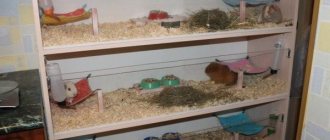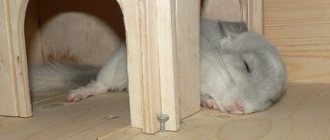In addition to a spacious cage and a running wheel, the owner must also take care of a house for the hamster, in which the pet will spend most of its time. But sometimes the animal, for unknown reasons, refuses to enter its home. Why doesn’t a hamster sleep in a house, and how to choose the right house so that it suits the picky animal’s taste?
Why does a hamster refuse to sleep in his house?
When choosing “furniture” for a Djungarian or Syrian hamster, you should pay attention not only to the size of the house, but also to the material from which it is made. A rodent will be most comfortable in a wooden dwelling, since plastic products can scare away the animal with a sharp, unpleasant odor.
In his house, the hamster not only sleeps, but also uses it as a personal pantry, storing grains and pieces of vegetables in it, because natural instinct forces the animal to stock up for the winter. Therefore, this piece of furniture should be quite large and spacious.
If the pet refuses not only to sleep, but even to enter its home, then this can be explained by several reasons:
- The animal does not like the smell of the product. This problem occurs especially often if the house is new. Before placing this item in the cage, it must be washed and treated with a disinfectant to kill all bacteria and eliminate foreign odors;
- Sometimes a rodent refuses to sleep in a house in the summer because it is too hot for him there;
- Another possible reason that a pet has rejected its home may be that it is uncomfortable and uncomfortable there. You can solve the problem by buying a new piece of furniture for the animal;
- Perhaps the hamster stopped sleeping in the house because his paw was pinched by the door and the pet is simply afraid to enter it. In this case, the door should be removed so that the entrance is open and accessible;
- It may also happen that the animal suddenly begins to use this object as a toilet and naturally does not want to sleep on wet sawdust. If this happens, the product should be washed and placed in the corner of the cage where the rodent sleeps.
Winter dream
With the arrival of winter, hamsters begin to realize that the days have become shorter and it is time to sleep. In order for rodents to maintain the required body temperature during this period, they need to constantly eat. The hamster is an intelligent and economical animal. He knows that if he constantly eats up his reserves, he may not live until spring. Therefore, in winter, rodents hide in their house and go to bed until spring.
At home, the hamster sleeps during the day and runs around at night. But do they hibernate?
Hibernation in domestic rodents
The hamster has its own cycle according to which it lives. At home, hibernation does not occur every year. But when hamsters sleep day and night also on their backs, the first thing the owner thinks about is that the pet is probably dead.
There is no need to panic, first you need to check whether the animal has died or has simply become numb for a while. Yes, this happens in rodents of this species. In order to find out what happened to him, it is worth knowing the reasons for the numbness.
Why doesn't the hamster leave the house?
There are also the opposite situations, when a furry pet does not leave its house for a long time. Why does this happen and what should the owner of a miniature rodent do in this case?
If the hamster was just brought home from the pet store, then it needs several days to get used to the new environment. These cute creatures are very shy, so it is quite normal for the animal to hide in its home for the first time and not come out.
Hamsters are afraid of noisy sounds, so the hamster could have been frightened by loud music or screaming and preferred to retreat to the only safe place for itself - its cozy house.
If there is a cat or dog in the house, then perhaps it was these animals that scared the miniature rodent.
But, if at the same time the pet does not leave its home, even to eat or drink, then the reason may lie in some kind of disease. In this case, the owner needs to remove the animal from the house and inspect it. At the slightest suspicion of illness, your pet should be taken to a veterinarian.
Why do they hibernate?
A hamster sleeping for long periods of time is not a good thing.
If an animal sleeps all day and night for several days, then this is torpor. For rodents living at home, this is not a normal process, because there are no seasonal changes in the premises. Therefore, it is worth finding out why the hamster constantly sleeps and does not run at night.
Causes of numbness at home:
- The air temperature is too low. When the temperature in the house drops sharply, animals trigger the same instinct as their wild relatives. Therefore, it is better that the air temperature is not less than 15 degrees. Otherwise, numbness will set in instantly.
- The room is constantly dark. It is not recommended to keep rodents in the sun, but darkness also has a negative effect on them. Homa associates constant darkness with shortening daylight hours.
- Poor nutrition. Lack of vitamins and minerals in a hamster's diet can also lead to torpor. Therefore, in order not to bring the animal to such a situation, it is worth feeding it correctly. Give not only grain, but also fruits and vegetables.
- Stressful situations. Severe stress can put an animal into a coma. He will constantly sleep, which will allow him to survive such a shock.
More often, stress for such animals comes from the breeder’s untimely desire to play with him. You should not touch him when he is sleeping or eating. Such irritation can drive him to stupor.
But this is not the main cause of stress. Most often it becomes fear. At the same time, the homa literally loses consciousness. Therefore, in order for your animal to lead a normal life, it must eat properly, not be stressed and be in a normally lit room.
Symptoms
People who encounter this phenomenon for the first time cannot immediately identify numbness. In a state of sleep, hamsters breathe slowly and their heart rate decreases. The rodent's entire body goes into a kind of economy mode. Body temperature during this period is within normal limits. Sometimes the pet may get up to eat. With the arrival of spring they wake up.
Main symptoms of numbness:
- the animal does not move;
- body temperature drops;
- the pet does not respond to its name;
- the animal breathes, but very weakly.
A pet can sleep in this state for 2 months. To check whether a Homa is breathing or not, just hold a mirror to his nose. If it fogs up, it means the rodent is simply numb.
How to calm a hamster at night
It is natural for hamsters to sleep during the day and be active at night. And it is precisely this mode of these rodents that creates some inconvenience for the owners, since the animals keep them awake with their noise. Therefore, owners of furry pets are wondering how to make a hamster sleep at night and stay awake during the day?
It is impossible to explain to the animal that it should sleep at night, but there are several ways to minimize the level of noise it creates.
- To prevent the running wheel from knocking and squeaking while the hamster runs, it is advisable to attach it to the cage and lubricate it with vegetable oil;
- If your pet chews the bars of his cage, then you can give him several special chewing toys for this purpose, on which he will grind his teeth;
- Food plates should be made of heavy materials, such as ceramics, so that the rodent cannot move them around the cage;
What to do if the hamster still makes noise at night, and the above methods are ineffective? Just take the cage with your pet to another room so that it doesn’t bother anyone.
A hamster, like any pet, needs attention and care. Therefore, before getting a furry rodent, you should prepare everything necessary for it so that your miniature pet can feel calm and comfortable.
Sooner or later, any hamster owner will be faced with the fact that his pet will escape from the cage. In such a situation, it will be more effective to lure the rodent rather than look for it.
We will find out what to do if a hamster escapes, what baits can be used and how you can prevent your pet from escaping.
- Why can a hamster escape from its cage?
- Where could the animal be hiding?
- How to find a hamster?
- How to catch a hamster in an apartment?
- Treats and baits
- Toys
- Safe traps
- How to prevent escape?
How long can a hamster sleep?
A small rodent can sleep up to 10 hours a day. To protect themselves from dangers that may arise at night, hamsters sleep during the day. Syrian and Dzungari are no exception to this rule. Some go to bed at 9 am, and others at 7, each rodent chooses the optimal time for itself.
An animal's sleep is greatly affected by changes. If he is moved to another place or another house, he will begin to behave completely differently. A rodent has two types of behavior:
- Activity is when a pet shows interest in everything that is around it. He settles down in his own house. During this period, the animal has little time to sleep. Hamsters adapt to a new place within seven days.
- The second type of behavior is sleep. The hamster sleeps in his house all day and leaves it only to eat and drink. How much do hamsters sleep during this period? A rodent can sleep about 20 hours a day.
This is normal animal behavior and there is no need to worry. If you hear from someone that a hamster does not sleep during the day or sleeps at night, do not believe it. These animals have a regime opposite to ours. At night they are awake and constantly spin their wheel, which prevents their owners from sleeping. And during the day they sleep peacefully in their house.
Remember, it is impossible to wean this animal from sleeping a lot, it is inherent in their nature.
Where could the animal be hiding?
Rodents like dark, narrow spaces where they can hide or crawl around in search of adventure.
The main places where a hamster can escape:
- spaces under furniture (sofas, cabinets, armchairs);
- various boxes, drawers, open shelves of cabinets;
- places with free access to treats (buckets of apples, a cupboard with sweets);
- bed linen, bedspreads, pillows.
Important! If this is not the first time your hamster has escaped from its cage, it is advisable to check the place where it could have been found before.
How to find a hamster?
If your pet runs away, first of all, you shouldn’t panic. It may not be possible to immediately catch a hamster in the house, and it will take time to find the fugitive.
Important! Actively searching for a runaway pet by moving or turning over furniture carries the risk of crushing a small, fragile animal. And slamming cabinets, interior doors and stomping will not only not help you find it, but can even scare the hamster away.
If the hamster has escaped, then you need to ensure that it remains as safe as possible until it is returned to the house. You should tightly close the door to the balcony, from where it can fall, and remove household chemicals, medications, and any toxic substances higher than the floor level. Cats, dogs and other animals that can cause harm should be isolated for a time in a room where the pet is definitely not present. Otherwise, they may find the hamster faster than the owner.
The hamster is predominantly nocturnal. He feels calmer in the dark and becomes more active as dusk approaches. Therefore, it is much easier to find a lost animal in the evening.
It is necessary to create silence, turn off the lights in the apartment and listen. The fugitive will detect a grinding or rustling sound, after which you can carefully approach the place where the sound is coming from. It is important at this stage not to scare the fugitive, otherwise he may hide deeper and get completely lost, and you risk not finding him for a long time.
Another way to find an escaped hamster is to dust the floor with flour and sprinkle food on it. A hungry hamster will come running to satisfy its hunger, and after that it can be found by following its tracks.
Is it worth waking up the home?
If the hamster stops playing and sleeps all day, then he has gone into hibernation. There are two options here: either wake him up or let him sleep. What is the right thing to do? And here it all depends on the physiology of the hamster.
It is recommended to wake up your pet if he is numb from the cold. But this must be done according to the rules. You need to immediately warm the animal well; to do this, take it in your hands. Heating devices cannot be used for this.
Hold it in your hands and stroke it gently. You will notice how over a period of time his body will become warmer and his breathing will become more frequent. After which your pet will begin to slowly move, which means that he is waking up.
If the rodent fell into hibernation due to severe stress, then it is better to let it sleep well. How long his sleep will last depends on the degree of stress and the pet’s health.
How to catch a hamster in an apartment?
The pet must be caught extremely carefully. Under no circumstances should you grab roughly or try to cover with heavy things (bowls, pots). It is better to let your pet escape than to cause injury.
The safest way to catch it, although not very fast at first glance, is to lure the hamster or dwarf with food. In the wild, he will certainly get hungry and miss treats and toys. And if the hamster is able to find meager food within the apartment, then he will have to return to the cage for a drinking bowl.
Treats and baits
Rodents are afraid of open spaces, so it is better to place baits not in the center of the room, but along the periphery. Capture options:
- The cage works well as bait.
Inside, in a visible place that the pet can easily find, you need to put a drinking bowl with clean water and place the food that the hamster likes most. Usually these are nuts, seeds, crackers, vegetables or sweet fruits. When the animal is inside, the owner simply needs to close the door.
- A simple bait is made with a tasty treat and a light cardboard box or towel. The hamster's bowl is placed on the floor, or food is poured in. This requires the owner's constant attention and silence. When the pet smells food, it will run out of the shelter. At this point, it is covered with a box or light cloth. This must be done carefully to minimize stress and not cause harm to the animal.
Important! You should not wash the cage before the hamster is back in place. The familiar smell attracts him back, instills a feeling of security. He is more likely to return if he senses the marked territory.
Toys
A hamster may become bored with freedom due to the lack of favorite attractions: wheels, balls, ladders, tunnels. All this can be placed next to the place where he was last seen. It is possible that soon after this the animal will come out to engage in its favorite pastime.
Safe traps
Homemade traps can help catch an escaped hamster and at the same time keep your beloved pet safe and sound.
This trap is suitable for animals that do not like to be held and are not used to it. It is made very simply. One end of a paper towel or toilet paper roll is sealed so that your pet cannot escape. A treat is poured inside. The open end of the trap tube is placed at the place where the escaped hamster is supposed to be hiding. Once it is in the sleeve, the owner can safely move it home.
- Bottle trap.
This is a rather complex design. It is assembled from a plastic bottle and rubber bands. The bottom of the bottle is cut off on three sides so that it rests on only one wall. The cut part is folded back and fixed, as indicated in the photo, with an elastic band. A cardboard bridge is placed inside the trap, which should preferably be rubbed with something tasty and aromatic, such as peanuts. The treat itself is placed deep in the bottle. The hamster will climb inside for food, but will not come back out, and the owner will be able to easily find him.
A bottle trap is theoretically dangerous for the animal, since the rubber bands can come off or burst. With this method of catching a fugitive, it is better to foresee a similar outcome of events.
A large amount of hay or sawdust is placed at the bottom of the bucket so that the pet does not hurt itself. A ladder is built to the top, which is a ladder made of books. A piece of treat is placed on the middle and last step.
The hamster will climb the ladder out of curiosity and the smell of food, and when it ends up on the piece of paper, it will slide to the bottom of the bucket. Due to the high walls, the hamster will not be able to escape without the help of its owner.
How to prevent escape?
It doesn't matter if the hamster ran away one or more times. Immediately after the fugitive is found, it is necessary to think about the reason for what happened and think about the mistakes.
To prevent this from happening again, you need to:
The likelihood of your hamster getting lost becomes much lower if you make sure that it feels comfortable, loves its owner, and is comfortable with being touched. In this case, even if he accidentally runs away, it will be much easier to find him.
The correct daily routine of an animal
Many breeders complain that the rodent sleeps for a very long time. We can say that a pet thinks the same about its owner, who sleeps at night. But what kind of regime do hamsters have?
Hamsters are nocturnal animals, but they have a routine, just like people. To understand the health status of your pet, just look at how much he sleeps. The norm for rodents is as follows:
- if a hamster sleeps 8 hours a day, then this indicates that he is very active;
- sleep at 10 o'clock indicates that the animal is in good physical and mental condition;
- if a hamster sleeps for 14 hours, it means you have acquired a lazy person;
- but if the duration of sleep is more than 14 hours, then not everything is in order with his health.
It is worth remembering one single rule: if the rodent is resting, then there is no need to touch it. You shouldn’t wake him up just to give him a treat or take him for a walk. Wait until the animal gets some sleep, and then have fun with it as much as you want. Teach him that after sleep he begins a period of special activity, games, food, self-care.
If the hamster doesn't get enough sleep, it may bite. It is also not recommended to try to create a regime for the animal that you like. This is not possible, because as mentioned above, the hamster is a nocturnal animal, and it will not be able to stay awake during the day. If he interferes with your sleep, simply place the cage in another room.
My experience with homa disease. EVERYONE SHOULD KNOW THIS.
To help those who have the same symptoms.
When your hamster starts behaving strangely, gets sick, or suddenly you urgently need advice, immediately open Google and start typing in your question.
Daisy was my first hamster. Furry family member, small child. Our princess. We spent every evening together.
Fluffy Syrian hamster. I very often opened Google and looked for information on care, nutrition, appearance, etc. I often found what I needed, but these were posts on forums where, unfortunately, there was no ending to the story.
Daisy passed away today. She was one and a half years old, she could have lived longer, but unfortunately she could not cope with pneumonia. And this is the worst thing, that she died not from old age, but from a disease that could have been prevented and cured if the symptoms had been immediately noticed. Let my sad experience be a lesson for everyone. Let this story have an ending. I want you not to repeat my mistakes.
Throughout her life, Daisy was ill 2 times, 2 of them were fatal.
Poisoning (bloating, inactive behavior, no appetite).
She was one year old. It so happened that she ate white cabbage and raw potatoes. As you know, this is a heavy food for hamsters, which can be fatal!
1- She didn’t leave the house all evening (it happens that in the evening we find ourselves in a period when she’s sleeping, and we go to bed without seeing her). The next day it became clear that she did not go out at night, the food remained untouched.
2- We took her out of the house, she looked at us, did not utter a sound and did not move. She just sat calmly on her hand and didn’t run anywhere (which is very surprising).
3- It’s worth remembering right away that it was not as usual. New bedding, toy, food, sand? We remembered about cabbage and Google to help us. We found that you can solder a hamster with a dill solution. We crushed the dill seeds, poured hot water (I think it would be better to boil), and served her the warm solution. We didn’t have a syringe, we served it on a spoon, she got 2-3 drops. The next morning she was already running in the wheel and ate all the food.
4- Why did Google come to our aid, because it was night, and all the clinics that I called did not treat “exotic animals” or offered to make an appointment with a qualified veterinarian who is available for appointments on certain days. If you have a hamster, it is better to immediately find a clinic that treats them and works around the clock, because hamsters are nocturnal animals, more often than not you will notice that something is wrong with them already at night.
5- This story ended well. I had dill seeds and just wanted to plant them on Daisy's windowsill.
Result:
-Always Google what a hamster can eat!! Even when it seems to you that it is completely ordinary food! Phrase: “Yes, in nature they generally eat just about anything!” inappropriate here. Hamsters don't know what they can eat and what they can't, so you are responsible.
-Buy dill seeds. Hamsters often experience indigestion. If you didn’t notice, he’s already chewing your flower or collecting crumbs from the table.
-Immediately find a VETERINARY CLINIC. There are very few hamster specialists.
Colds, pneumonia (eyes fester, weakness, wheezing, rapid breathing).
I don't know exactly when it started. Perhaps she cared so much in one day, or perhaps it lasted for several days. But I will capture as much time as possible.
1 - Mon - morning. I noticed that one eye was somehow closed and they were wet, it was not clear whether she had just stood up and that’s why she was so wrinkled, or whether something was wrong. But she behaved normally. I was running, my appetite was good. We left for work. In the evening she was already as usual, not a hint of wet eyes. Just in case, we washed everything and changed the bedding.
2- Wed night. Daisy was making strange sounds, not a squeak, not a sneeze, but some kind of chirping. Now I think that perhaps it was a cough; few people know how hamsters cough. She looked normal, we assumed that she was just washing herself in the house, she sometimes made a couple of such sounds.
3- Thu- we bought her hazel sticks, new sand for cleaning, food. This purchase later led us astray.
4- Sat-evening. Daisy slept for a long time again, we didn’t see her that evening, which was a big mistake.
5- Sun-evening. Daisy came out of the house and was in a terrible state! The eyes were festered and there was blood. We decided that it was because of the new sand or that we had gotten some bad sawdust - here we were wrong (((
-We washed her eyes with chamomile. They removed everything from the cage, washed it and left only the house, they didn’t even put down the sawdust.
- An hour passed, Daisy left the house and could not walk normally, she fell on her side, her eyes were stuck together again. In an hour.
- of course, an urgent call to the clinics, who will take the hamster at night? Google symptoms. On the 8th call I got to the right place, we were offered to give the hamster cycloferon (1/16 (1/4 in half, then in half) part of the tablet or intramuscularly). But it’s one thing to give dill to drink, another thing to give serious medicine. We got ready and took Homa to the hospital. By the time she arrived, she was just lying there and not moving. There was rapid breathing.
The veterinarian listened to his breathing (there were wheezing), conducted an examination, tried to check the temperature, but to no avail. All symptoms pointed to a cold. They gave her 5 injections! They left her for observation overnight, but immediately said that she had little chance, her condition was too bad + her age. This morning they called and said that she was gone...
Result:
-look at the hamster every day.
-If you notice something strange, then immediately find the reason.
-And most importantly, Khomas are very sensitive to temperature changes. We had heat, but then the gas was turned off for 2 weeks; when we were at home, the heater was working; when we left, it was turned off. The summer in our region was cool, perhaps she caught a cold because of this, and on Saturday while cleaning I opened the window, Daisy was far from it, but there was a draft and that was enough for her. It was the last hot day of summer outside, today it was cold, +7 degrees.
PS. This is my first review - I apologize if anything is wrong and for any mistakes.
A hamster is often purchased because it is a small and fairly unpretentious animal. It takes up very little space, and watching its fuss is a pleasure. However, even though the pet is undemanding in care, owners sometimes make certain mistakes in its maintenance that should not be made.
How to attract your pet's attention to his sleeping place?
Many novice breeders of hamsters complain that their pets refuse to accept houses installed in cages. Don't be afraid of this. First of all, you need to make sure that the baby is comfortable in his living space. Often you have to purchase several similar accessories so that the animal can make one of them its home.
To attract your pet's attention to a new accessory, sometimes it is necessary to place a small amount of sawdust in it, in which the baby previously slept. Many people recommend putting a small amount of the animal’s favorite food there. In such cases, the likelihood that the hamster will settle into a new sleeping place increases. It is important to carefully observe the behavior of the individual to understand whether it is healthy, and then draw conclusions explaining the reasons for abandoning the house.
Article on the topic: How to bathe and wash a land turtle (Central Asian) at home
If your pet does not have bald spots or matted fur, his eyes are clean, there are no signs of diarrhea on his fur, and he has calm, even breathing, there is no need to panic. Perhaps after a while the baby will show interest in an unusual sleeping place. If this does not happen, the accessory can be left if it does not take up much space. If the hamster cannot move normally around the living space, it should be removed until better times.
Keep a male and a female in the same cage if you do not plan to have babies
Some inexperienced owners buy a pair at once - a female and a male, believing that they will have much more fun together.
However, one should not rush to conclusions. If you put a boy and a girl in the same cage, then one day they will make you happy with offspring. And it will not be one or a couple of small animals, but at least a dozen at once.
If you are not ready to breed these rodents, then it is better to purchase one. Hamsters themselves are not social animals; they do well without company, in splendid isolation. And so that they don’t get bored, you can place various wheels, labyrinths and hammocks. Nowadays you can find a wide selection of products in the pet store.
Purpose of a house in a pet's cage
Buying a house for your pet is easy. You can buy the accessory at a pet store, order it online, or even make it yourself. At first, it is recommended to install not one, but several, so that the hamster can make his choice. It should attach freely to the cage rods. The main purpose of such an accessory in the animal’s cage is to organize a sleeping place for it and a warehouse for dry food.
When choosing a house, you should pay attention to such points as:
- ease of cleaning;
- ease of disinfection;
- ease of opening.
Article on the topic: What to feed a puppy at 1 month
Using the wrong bedding
In order for a hamster to feel comfortable and please its owners with its healthy appearance and active games, it needs to choose the right food, change the water often and use the right litter for the cage.
You can find a lot of bad advice on numerous forums on the Internet. For example, that rodents love rags. Bury yourself in them and live there. However, this is not at all true. The rags will quickly absorb dirt and become unhygienic. Besides the fact that it will emit an unpleasant odor, and aromas are important for hamsters.
Other materials such as:
- softwood shavings;
- cat litter.
Good, quality bedding material is very important for your pet. At the pet store you can find:
- Hay. You can not only purchase it, but also prepare it yourself. The hamster will be able to make a nest out of it and even feast on it on occasion. However, its environmental friendliness is not always guaranteed.
- Sawdust. This is an inexpensive and universal litter that is suitable for any rodents. However, due to their very light weight, they will be not only inside the cage, but also outside it.
- Wood pellets. Or pressed sawdust. They absorb odor better than all of the above and are environmentally friendly. However, some types of hamsters will not be comfortable living on the pellets as they are quite large in size. In addition, they contain wood dust, which does not have the best effect on small animals.
- Cellulose filler. Externally, it also looks like granules, but not as large in size as wood. They are the safest and most convenient. But they don't absorb odor so well.
The following compounds are strictly not suitable:
- Newspaper. This filler was used quite widely in the past for lack of anything better. However, printing ink alone can cause irreparable harm to your pet's health.
- Plain paper. The hamster will definitely try it on his teeth and may be injured by the sharp edges.
- Cotton wool. Some people also use this kind of filler, motivated by the fact that it will be a cozy nest. Maybe the house will actually turn out to be quite good, but the fibers of this material can wrap around the paws and cause irreparable harm to the limbs.
The issue of bedding for a small rodent should be taken very seriously.
Reasons for not wanting to sleep in a house
Despite the fact that an accessory for a hamster can cost a lot of money, since it is made of high-quality, environmentally friendly material, many are faced with the reluctance of the hamster to be inside. The main reasons are considered:
- the presence of a peculiar odor - usually a similar phenomenon is observed if the accessory is made of low-quality material. To eliminate the smell unpleasant to the pet, it is recommended to disinfect the home, move it to the place where it sleeps and put the sawdust from which its nest is made inside the house. This way the smell will become familiar to the animal;
- heat - not all accessories are equipped with a kind of ventilation system. If the pet is hot in it, he will refuse to sleep inside;
- lack of amenities - perhaps the baby does not have enough space inside a small home. In such cases, you can replace it with a larger one.
In addition to the above, there are other reasons that explain the reluctance to climb into a specially designated place while sleeping. Considering the fact that this is a nocturnal animal, it is worth making sure that as little light as possible falls on the sleeping place during the daytime.
Poor nutrition
Before you get yourself a furry pet, you should definitely familiarize yourself with its diet. Some products are strictly prohibited for him. For example:
- cabbage - any variety;
- milk - in its raw form causes severe distress;
- garlic;
- onion;
- some fruits, especially those that are too sweet.
Incorrectly selected products can not only cause disruption to the hamster’s gastrointestinal tract, but also injure its delicate body.
Solid foods must be present - for example, carrots. The rodent will sharpen its sharp teeth on it. Otherwise, they can grow greatly and become a real problem for him.
Failure to study the main signs and symptoms of diseases
It is imperative to know the symptoms of certain diseases. After all, prevention is the best treatment. A timely visit to the veterinarian can save your pet and help avoid many problems.
It is worth paying attention to changes in the behavior of your furry pet. Reasons for concern may include:
- excessive activity and lack of sleep;
- lethargy;
- lack of appetite;
- sadness.
If you find this, be sure to contact a specialist.
Allow your hamster to get fat
A fat hamster may look cute, but it can be dangerous for his health. Excess weight puts a lot of stress on bones and joints. Therefore, proper nutrition and daily exercise are simply necessary for your pet.
By following these simple rules, your pet will delight your household with its cheerful appearance and disposition for a long time. The most important rule is care and attention.
- Why do hamsters run away and how dangerous is it?
- What to do if your hamster goes missing?
- How to lure a hamster out of hiding?
- So that this doesn't happen again
One day the hamster Mango was very bored in his cage. To somehow entertain himself, he began to play with the shiny door - stand on it with his paws and poke his muzzle into the latch. And, lo and behold, the door opened! (It’s clearly time for the owner to change the locking mechanism). Mango is free! He deftly jumped from the table to the chair, carefully went down to the floor and went to explore the huge three-room apartment. But, in addition to the hamster and the owners, it was also home to a Jack Russell terrier, Jesse, and a two-year-old baby, Leva. It’s scary to think how many dangers could have fallen on the cheeks of the handsome fugitive if not for his responsible owner... He regularly read articles on the Tail News portal and knew how to act in such a situation. Do you want to know how to quickly find a missing hamster? Then let's go!
Why do hamsters run away and how dangerous is it?
Hamsters could compete for the title of the most curious pet on the planet!
These animals are very active, dexterous, playful and smart. If the hamster has a chance to escape from the cage, believe me, he will not miss it! But will the “big trip” benefit him? Any rodent specialist will answer that no. For a full, happy life, a hamster needs a spacious cage. They are generally not recommended to be allowed out for walks outside of the park.
It's only in theory that a hamster's escape seems funny. In practice, the risk is too high that this adventure will end in failure. What awaits the hamster in the apartment is not an exciting Disney Land for rodents, but very real dangers. These include small objects that can be swallowed, sockets and cables that can give you an electric shock, narrow gaps where you can get stuck, and heavy objects (as well as your feet) that you can accidentally get under. And if the cage is installed on a high surface, then you won’t have to go far to find danger. A hamster can fall and seriously injure itself as soon as it begins its journey.
What to do if your hamster goes missing?
Ideally, it is better to prevent situations where the hamster can escape from the cage. But we are all living people, and no one is immune from mistakes. So what should you do if your hamster runs away? How to quickly find him before trouble happens? Let's take it step by step.
- Try not to panic and inspect the cage carefully. Check all the nooks and crannies: the house, the tunnels, the hammock. Surely the hamster is not hiding somewhere within his home?
If there really is no hamster in the cage, warn all family members: let them be careful!
- Animals and small children who may unknowingly cause harm to the pet should be isolated in another room or closely monitored. Even if your cat or dog was exceptionally friendly towards the hamster, it’s not worth the risk. Hearing rustling behind the chair, the pet may behave not like a “friend of rodents”, but like a hunter.
- Close the door of the room where the cage is located. Cover the gap under the door so that a savvy rodent does not run to another part of the room and complicate your search.
- Carefully inspect the area closest to the cage. Don't run into the next room to search. At first after escaping, the hamster most likely will not run far and will sit out somewhere nearby.
- Remove rodent and insect poisons and household chemicals so that the hamster does not taste them.
- While searching, move along the walls and inspect the space below. Hamsters usually do not go out into the open and do not try to climb higher. Inspect the space behind cabinets, cracks under furniture, shoes, carpets, and any secluded places where your furry can hide.
- Do not move furniture. This could cause you to hit and seriously injure your hamster.
- Do not make noise. Ideally, turn off all sources of noise, create silence in the room, turn off the lights, sit quietly in a chair and listen. Most likely, after a few seconds or minutes, the hamster will give itself away by rustling.
- Calling a hamster is completely pointless. It is not a dog or a social rodent like a rat. He won't run into your arms. On the contrary, hearing your loud, excited voice, the hamster will get scared and sit in the shelter for a long time.
How to catch a hamster if you've blown its cover? It is best to put treats on your palm and lure the baby. If the hamster is not tame, catch it with a net (or hat). It is better not to use heavy objects such as pots and basins: this can cause injury to the fragile rodent and will greatly frighten it.
How to lure a hamster out of hiding?
A runaway homa is unlikely to miss its owner and will definitely not run out to meet you. But he will miss food very soon.
On the Internet you can find many options on how to lure a hamster out of its hiding place with a treat. Some of them are very creative. But we recommend using the most effective and safest method. Simply place an open cage on the floor in the center of the room and place your traveler's favorite food in it. Feeling the familiar smell of home and favorite food, the homa will return to the saving walls of his shelter. All you have to do is close the door behind him.
For greater reliability, scatter “bread crumbs” along the way to the cage: these can be seeds or grains. The hamster will use them to get to the cage. The main thing is not to overdo it with their quantity, otherwise the rodent will eat and return to its temporary shelter.
Other methods, such as luring the hamster into a bucket or bottle, often result in injury or have no effect at all.
After catching the rodent, carefully examine it. Was he hurt? Did you hurt yourself? If damage is found, contact your veterinarian.











